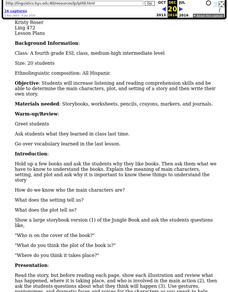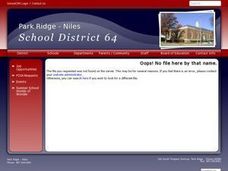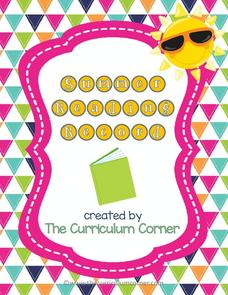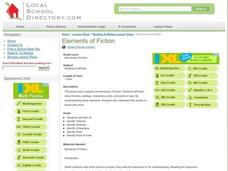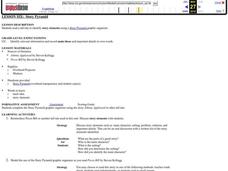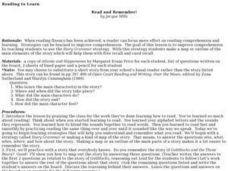Curated OER
Language Practice
The simple instructional techniques described in this plan will help young readers learn and practice basic reading skills and strategies. Before reading, introduce your readers to the meaning of main character, setting, and plot. Then...
Curriculum Corner
Fiction Graphic Organizers
Get an in-depth look into a narrative text with a three-page worksheet that examines a story's character—actions, sayings, thoughts, and appearance—setting, and challenges scholars to write a brief summary about what they've read.
Curated OER
Setting's Effect on a Character's Actions
Do the actions of a character in a story change based on the setting the writer provides? Learners explore the concept of character action in relation to story setting by investigating the setting and events in the story Science...
Curated OER
An Author Study on Kevin Henkes
To better understand how the author Kevin Henkes uses the theme of friendship throughout his books, learners engage in several compare and contrast activities. The class reads several Henkes titles and discusses the similarities in...
EdHelper
George Washington's Socks by Elvira Woodruff
A solid, straightforward book report form is an excellent addition to your literature unit. Class members note the main characters, point of view, plot elements, and other important details from a story, adding their favorite part...
Curriculum Corner
Fiction Graphic Organizers
Analyze a fictional text with a four-page packet that explores a story's main character and moral, challenges scholars to ask and answer questions about the text, and to create a story map.
Curriculum Corner
Summer Reading Record
No more summer reading lag! Give young readers a set of graphic organizers and worksheets to keep track of the books they read over the summer and to keep reading comprehension skills fresh. The graphic organizers include identifying...
Ed Helper Clip Art
Character Problem Solution
Intended for younger audiences, children identify the main characters, setting, problem, events, and solution in a graphic organizer.
Curated OER
Nursery Rhymes
Learners recall details of nursery rhyme read by teacher, identify main characters, and demonstrate knowledge of poem by creating concept map about story that includes title, clip art, and changes in font and color.
Mr. Mansour
Ralph S. Mouse by Beverly Cleary
Take an in-depth look into Beverly Cleary's story, Ralph S. Mouse, with a 10-question worksheet that focuses on story elements. Scholars describe the main character, point of view, conflict resolution, and more! Then, conclude with...
Curated OER
Characters in Nathaniel Hawthorne's Stories
Learners read literature by Nathaniel Hawthorne and write an essay comparing the main characters in the two stories. In this character analysis lesson, students read the stories Young Goodman Brown and The Minister's Black Veil. Learners...
Curated OER
Characters' Feelings Or Motives
Fourth graders use the text, "Fair's Fair" to examine how characters' feelings and motives are built throughout a text through descriptive phrases. They look at what a character does and says to record on their writing frames. Finally,...
EngageNY
Close Reading of Thank You, Mr. Falker: Identifying the Superpowers of Reading
Third graders read excepts from the story, Thank You, Mr. Falker in order to gain practice in understanding an unfamiliar story by focusing on the details. They use a worksheet, embedded in the plan, which directs them to certain...
Syracuse City School District
Literary Elements
Address the literary elements in a piece of writing using these materials. The packet includes plenty of resources, and focuses mainly on theme, character, and point of view, with some materials for setting, symbolism, and author's...
Freeology
Summarizing
Scholars draft a summary using a graphic organizer featuring a story's characters, setting, main events, conflict, and resolution.
Florida Center for Reading Research
Comprehension: Narrative Text Structure, Story Pieces
An activity boosts reading comprehension by challenging scholars to answer questions about a narrative tale detailing elements—plot, characters, setting, theme, problem, and solution.
Curriculum Corner
Guest Teacher Plans Grade 5
Math, reading, writing, and word work; it's all here in a daily lesson plan created to support a substitute teacher in a fifth grade class.
Curated OER
Batter Up
Students explore personal achievement by reading a children's book. In this story analysis lesson, students read the book Batter Up, by Sue Muller Hacking and discuss the main character in the story and the actions that she takes to meet...
Curated OER
Elements of Fiction
Students identify key story elements in a fiction text. In this literacy lesson, students are introduced to the various elements of fiction such as the setting, plot, and theme. Students read a short story of their choice and identify...
Curated OER
Character Attributes in Writing
Third graders analyze the importance of characters in fiction writing and performances. In this theatre lesson, 3rd graders identify the important characteristics of a fictional character and how to portray a character through many...
Curated OER
Story Pyramid
Learners read tall tales to identify story elements. In this story elements activity, students read about Johnny Appleseed and Pecos Bill and use graphic organizers to record information. Learners read in small groups,...
Curated OER
Do You Know What You Just Read?
Learners answer reading comprehension questions using the "story grammar" technique. They listen to a story and then answer questions using the technique: main character, setting, main events, and resolution. Students complete an...
Curated OER
Remembering What We Read
Students discover strategies to help them better understand the stories they read. As a familiar story is read to the class, individuals practice answering basic questions about the main characters, settings, problems, etc. while...
Curated OER
Read and Remember - Story Grammar
Young scholars use the Story Grammar strategy to outline the main elements of the story which will help them with free recall and cued recall. The strategy includes: identifying the main characters in the story, recalling where and...
